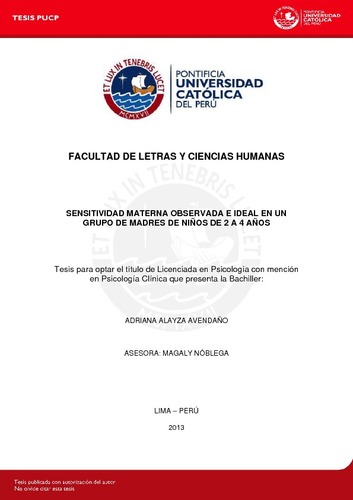| dc.contributor.advisor | Nóblega Mayorga, Magaly Suzy | |
| dc.contributor.author | Alayza Avendaño, Adriana | es_ES |
| dc.date.accessioned | 2014-02-07T16:46:42Z | es_ES |
| dc.date.available | 2014-02-07T16:46:42Z | es_ES |
| dc.date.created | 2013 | es_ES |
| dc.date.issued | 2014-02-07 | es_ES |
| dc.identifier.uri | http://hdl.handle.net/20.500.12404/5088 | |
| dc.description.abstract | La presente investigación tuvo como objetivo central describir la sensitividad materna observada en un grupo de madres de niños de 2 a 4 años de Lima. Asimismo, se buscó describir las características de la sensitividad materna ideal reportada por estas madres y establecer la relación entre su sensitividad observada e ideal. Para esto se contó con la participación de 16 madres entre 25 y 40 años (M = 32.06; DE = 4.23) con hijos de edades entre 2 y 4 años (M = 40.63 meses; DE = 6.22), pertenecientes al distrito de Los Olivos. Para la evaluación de la sensitividad materna observada e ideal se aplicó el Maternal Behavior for Preschoolers Q-Set (MBPQS) a modo de observación y de reporte de ideales. Los resultados obtenidos muestran que estas madres cuentan con un puntaje de sensitividad global similar al obtenido en un estudio realizado en el mismo contexto, pero notoriamente inferior que el de las madres de otros estudios latinoamericanos. Al comparar la conducta materna con el criterio teórico se encontró que estas madres proveen a sus hijos una menor seguridad para explorar el ambiente y responden menos a señales de malestar o estrés. Por otro lado, las madres del estudio presentan una idea similar a la sostenida por la teoría de lo que es una madre “idealmente sensitiva”; sin embargo, otorgan una menor importancia a las habilidades de una madre para monitorear el recorrido de su hijo, responder a señales de estrés y para anticipar posibles situaciones problemáticas. Finalmente, se encontró que no existen diferencias en los puntajes globales de sensitividad observada e ideal. Al mismo tiempo estos no se encuentran relacionados. | es_ES |
| dc.description.abstract | The present study aimed to describe the observed maternal sensitivity in a group of mothers of children with ages between 2 and 4 years old from Lima. As secondary objectives aimed to describe ideal characteristics reported by the mothers about sensitivity and to established the relationship between the observed sensitivity and their ideals about maternal sensitivity. Participants were 16 mothers between 25 and 40 years old (M = 32.06, SD = 4.23) of children aged between 2 and 4 years old (M = 40.63 months, SD = 6.22), that belong to the district of Los Olivos. Maternal Behavior for Preschoolers Q-Set (MBPQS) was used to describe maternal behavior and to report ideals held by the mothers. Results show that these mothers have an overall sensitivity score similar to that obtained in a study conducted in the same context, but significantly lower than the mothers of other Latin American studies. When compared observed maternal behavior with the theoretical criterion it was found that these mothers provide less security to their children to explore the environment and are less responsive to signs of discomfort or stress. In addition, mothers in the study have an overall similar idea of what is an "ideally sensitive" mother, when compared with the theory, but give less importance to the ability to monitor the child, respond to stress signals and to anticipate problematic situations. Finally, we found no differences in overall scores in the observed and ideal sensitivity. At the same time these are not related. | es_ES |
| dc.language.iso | spa | es_ES |
| dc.publisher | Pontificia Universidad Católica del Perú | es_ES |
| dc.rights | Atribución-NoComercial-SinDerivadas 2.5 Perú | * |
| dc.rights | info:eu-repo/semantics/openAccess | es_ES |
| dc.rights.uri | http://creativecommons.org/licenses/by-nc-nd/2.5/pe/ | * |
| dc.subject | Sensibilidad | es_ES |
| dc.subject | Maternidad | es_ES |
| dc.subject | Mujeres--Psicología | es_ES |
| dc.title | Sensitividad materna observada e ideal en un grupo de madres de niños de 2 a 4 años | es_ES |
| dc.type | info:eu-repo/semantics/bachelorThesis | es_ES |
| thesis.degree.name | Licenciado en Psicología Clínica | es_ES |
| thesis.degree.level | Título Profesional | es_ES |
| thesis.degree.grantor | Pontificia Universidad Católica del Perú. Facultad de Letras y Ciencias Humanas | es_ES |
| thesis.degree.discipline | Psicología Clínica | es_ES |
| renati.advisor.dni | 09823932 | |
| renati.advisor.orcid | https://orcid.org/0000-0001-6572-813X | es_ES |
| renati.discipline | 313026 | es_ES |
| renati.level | https://purl.org/pe-repo/renati/level#tituloProfesional | es_ES |
| renati.type | http://purl.org/pe-repo/renati/type#tesis | es_ES |
| dc.publisher.country | PE | es_ES |
| dc.subject.ocde | https://purl.org/pe-repo/ocde/ford#5.01.00 | es_ES |






